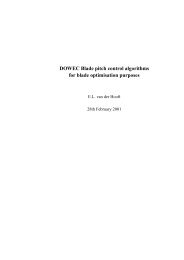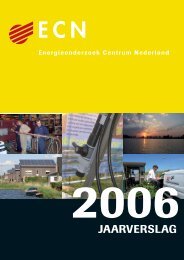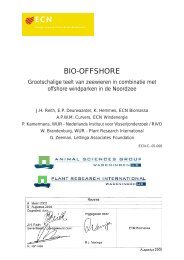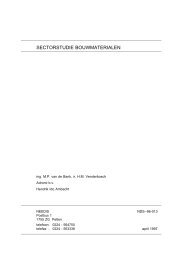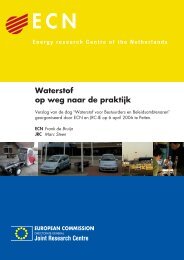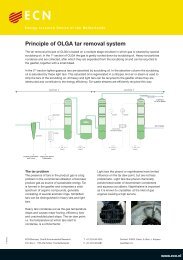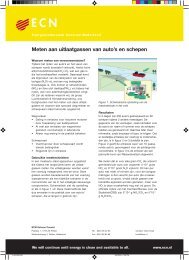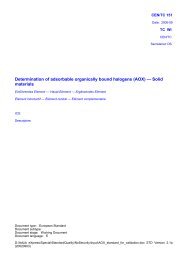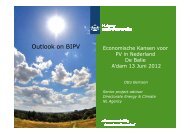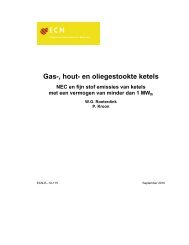PDF format (503 kB) - ECN
PDF format (503 kB) - ECN
PDF format (503 kB) - ECN
You also want an ePaper? Increase the reach of your titles
YUMPU automatically turns print PDFs into web optimized ePapers that Google loves.
Realising the 80% reduction potential by 2050 requires a considerable modification of the infrastructure.<br />
Changes in infrastructure are not included in this analysis, but it may be expected that these changes bring<br />
about substantial costs.<br />
The achieved high energy consumption reduction in 2050 requires two changes of vehicle types. On the short<br />
term, the shift will be made to the electric vehicle, while on the mid and long term fuel cell vehicles will become<br />
the new standard. It is not very likely that on a 60 years term two major changes of vehicle type will occur.<br />
The analysis of the transportation sector reveals clearly that both energy and material options contribute to the<br />
total saving potential. Modifications in the car construction (originating from/affecting the material production<br />
sectors) like the modified frame or the small passenger car offer a saving potential of 37% by 2050. Modifications<br />
in the automotive system (originating from/affecting the energy production system) have a saving potential<br />
of the same magnitude (39%). Options which make more efficient use of the transportation system (like<br />
doubling the occupancy rate) have the largest saving potential with 51%. In order to achieve the maximal saving<br />
potential in the transportation sector, both material and energy options should be included in the analysis.<br />
The analysis made in this paper may possibly contribute to the current discussion about reduction factors. In<br />
current discussions about sustainability the reduction factor approach is often mentioned. The in this paper calculated<br />
50% reduction by 2020 equals a factor 2 reduction in this year, whereas the 90% reduction by 2050<br />
equals a factor 10 reduction by 2050.<br />
In the general discussion about sustainability also other reduction factors are proposed: factor 4 - e.g. by the<br />
Wuppertal institute (Weiszäcker et al., 1997) - to be realised about the year 2025 and factor 20 - proposed in<br />
the Dutch DTO program (DTO, 1997)- to be realised in the year 2040. The factor 4 is based on halving the<br />
energy consumption at a doubled welfare level, this requires a reduction of 75 % in energy use per service. The<br />
calculations in this paper show that such a reduction is possible when introducing a number of nontechnological<br />
options. Without these options, the maximal reduction is a factor 2.<br />
According to the Dutch DTO program (DTO, 1997) a reduction by a factor 20 is possible for the year 2040.<br />
Three strategies are presented to realise this far reaching reduction: the introduction of renewable fuels, a new<br />
transportation system, and the introduction of an external drive system for vehicles. The introduction of renewable<br />
fuels comprises for example methanol derived from agricultural crops and wastes or hydrogen produced<br />
with photovoltaic electricity. The new transportation system integrates individual and collective passenger<br />
transport means, while the development of an external drive systems for vehicles reduces substantially the vehicle<br />
weight to be transported. The DTO study does not present a detailed implementation scenario and does not<br />
assess the relative contribution of each of these strategies, so a quantitative comparison with the DTO results<br />
and our findings is not possible. We suppose that the DTO strategies of a new transport system and external<br />
drive systems have about an equal effect (about factor 5) as the combination of options considered in this paper<br />
(such as a change of the modal split, doubling of the occupancy rate, and the introduction of the small car and<br />
the fuel cell or electric car). So DTO must assume an additional factor 4 reduction by means of renewable fuels<br />
to attain a total reduction of factor 20. Such an reduction implies a 75% transition to carbon-free energy sources<br />
and will have far reaching effects for the energy and the agricultural system.<br />
The total transportation related energy use is roughly equally shared by passenger and freight transport.<br />
Achieving a factor 2 c.q. factor 10 reduction in the total transportation sector therefore also requires a same reduction<br />
potential in the freight transport. The calculation of the reduction potential of freight transport can be<br />
made using the same methodology as for passenger transportation. Not all options for passenger cars can be<br />
implemented for freight transport. In general, most options seem to have a smaller energy reduction potential<br />
for freight transport than they have for passenger transport. For example, the modified frame results in about<br />
twenty per cent energy reduction for passenger cars, but only in ten per cent energy reduction for trucks<br />
(Bouwman and Moll, 1997). It seems that achieving an 80% energy use reduction in freight transport is much



